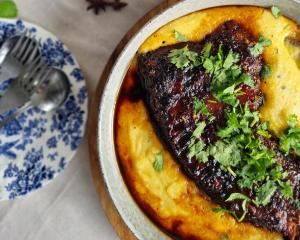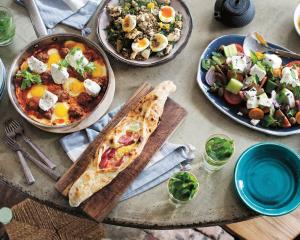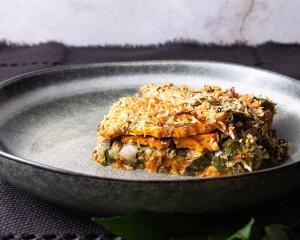
Due to their trifid-like tendency to spring up from nowhere and take over the veggie patch, the pumpkin is often unjustly regarded as a second-class vegetable.
In fact, it’s a fruit, and should be given due respect for its versatility, taste, and — at less than $4 a kilo (or even less if you throw a few seeds in your compost bin and wait) — it’s excellent value for money.
Part of the Cucurbitaceae or squash family, pumpkins come in different shapes and sizes; from the hefty Queensland blue with its ribbed blue-grey skin, to the smaller Kent or Jap pumpkin, to the ever-popular cylindrically shaped butternut with its sweet orange flesh.
Pumpkins are also high in vitamin A, which is essential for a healthy immune system, and have a long shelf life.
Store them at room temperature in a dry place and they’ll be good for at least a couple of months.
1. Roasting
Jo Whitton, cookbook author and founder of Quirky Cooking, reckons roasting is the way to go. "Roasted pumpkin will give a richer flavour than steamed pumpkin in mashes, pancakes and puddings," she says.
Whitton’s preferred pumpkin is the butternut, which she cuts into wedges, drizzles with olive oil and sprinkles with salt. "Roast in a hot oven until the seeds are crispy and the flesh is soft. You can then eat the whole lot — skin, seeds and all."
For a special brunch or supper dish, Whitton likes to bake eggs in mashed roasted pumpkin. She removes the seeds, adds garlic powder, onion flakes, salt, cayenne pepper, cinnamon and pepper, then mashes the pumpkin and spreads it on a baking tray. She then makes indents into the mash with a large spoon, cracks an egg into each one and bakes the whole thing.
Nigel Slater keeps the skin on roast pumpkin, too, but slices his and bastes it in the last few minutes with a paste of peanuts mixed with pomegranate molasses, a bottle of which will set you back about $5.
Hassan M’souli, of Manly restaurant Out of Africa, likes the sweet/tangy combination of pomegranate and pumpkin, too. He tosses warm roasted pumpkin with goat’s or feta cheese and pomegranate arils (or substitute with cheaper dried cranberries), then dresses it with olive oil and toasted pumpkin seeds.
2. Soups
Pumpkin soup is an enduring winter favourite. O Tama Carey, of Lankan Filling Station in Sydney, reckons that while you can boil pumpkin for soup, roasting before adding to stock "is one of the ways to coax the best flavour out".
For speed, Felicity Cloake roasts her pumpkin for soup in cubes, adding a handful of seeds to the baking tray towards the end of roasting to use as a crunchy garnish.
Meanwhile, Yotam Ottolenghi uses roasted chickpeas in his pumpkin soup, amping up the flavour with spicy harissa paste).
M’souli likes to make his pumpkin soup "thick and rustic looking," so advises not adding too much stock or water, although he does give the thumbs up to the addition of cream if you want a more luxuriant soup. He finishes his soup with chopped fresh coriander, grated turmeric and a sprinkle of cumin.
3. Curries
When making a curry, choose a pumpkin with a firmer flesh that holds together well, Carey says. She uses butternut pumpkin and adds boiled peanuts to her Sri Lankan curry, while Annabel Crabb’s version has roasted spices, coconut milk and cashews. Crabb advises not adding the pumpkin until the very end, so it stays in neat cubes.
Whitton also includes lentils for an earthy contrast to the sweetness of pumpkin but prefers hers softer, cooking it in stock with sauteed onion, garlic, spices, and lentils (and sometimes tomatoes) for about 25 minutes before adding coconut milk for the last five minutes of cooking.
4. Slow cooking
According to M’souli, in Morocco, pumpkin is most frequently cooked with meat in a tagine.
"It will then take on those meat juices," he says.
"My go-to is cooking pumpkin with apricots, raisins, prunes, saffron and caramelised onions in lamb tagine."
Ben Tish also travels the Moorish route in the recipe from his book, Sicilia, eschewing meat for a vegetarian pumpkin stew featuring chickpeas, raisins, cinnamon, olives and coriander.
Whitton likes to pair pumpkin with pork belly, an inexpensive, unctuous cut, slow cooking them in a chicken stock with onions and garlic until "the stock reduces down to a sticky sauce", then adding fresh green beans at the end of cooking.

5. Desserts
"Pumpkins have such an inherent sweetness I am surprised they don’t get used in desserts more," Carey says. She makes a baked pumpkin custard with cardamom, clove and cinnamon, plus a pinch of salt to temper the sweetness.
Whitton adds pumpkin to her brownie batter or cooks pumpkin in coconut milk with spices to make a pumpkin pie filling.
6. Leftovers
Always roast extra pumpkin and keep in the freezer, Whitton says.
"I use leftover roasted or steamed pumpkin in pancakes (blend with eggs and cook in a crepe pan), in Moroccan cauliflower couscous salad, in frittatas, on pizzas or mixed into scone dough for pumpkin scones," she says.
And if you’re lucky enough to have pumpkins in your garden, whether by accident or design, Carey points out that as well as the seeds, which are wonderful roasted (or try turning into a pumpkin seed "salt" like Tom Hunt does), the flowers and tendrils of pumpkin are also edible.
One way to use the flowers is to wilt them in a hot pan with olive oil and mix through just-cooked pasta with bacon and grated parmesan, while the crunchy, mild tendrils can be added to salad or stir-fried. — The Guardian
Next week:
See Plant To Plate in next week’s Fresh for more pumpkin inspiration.













